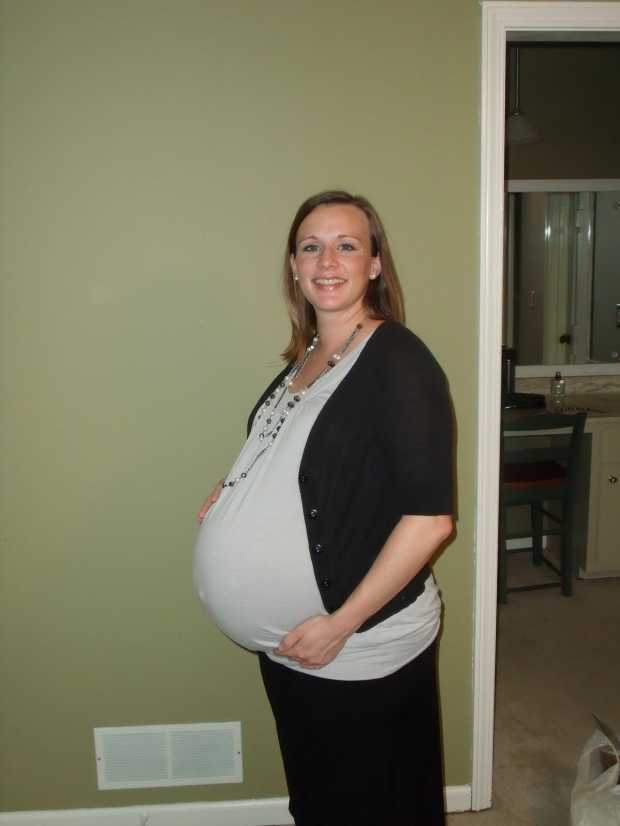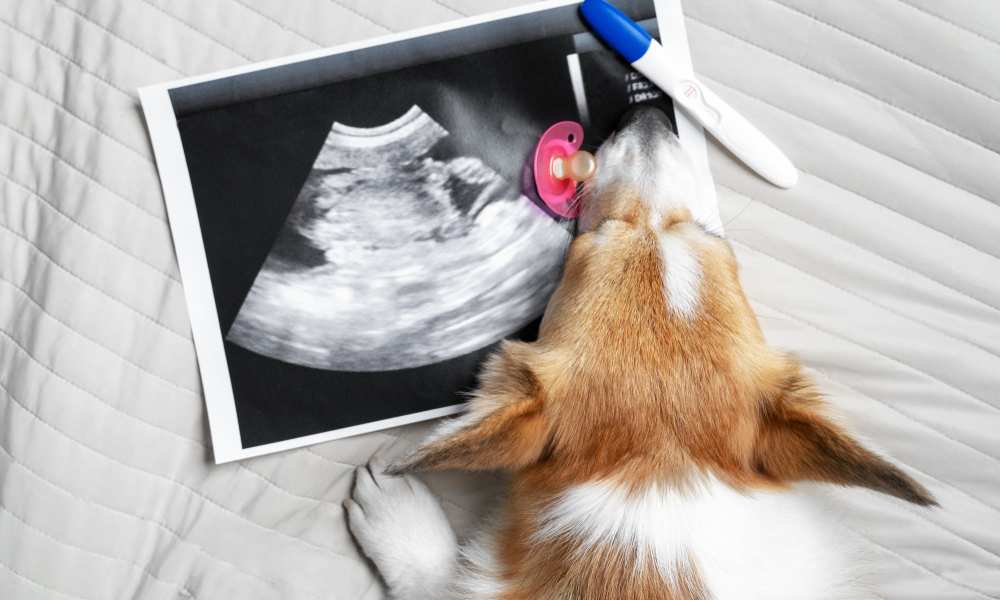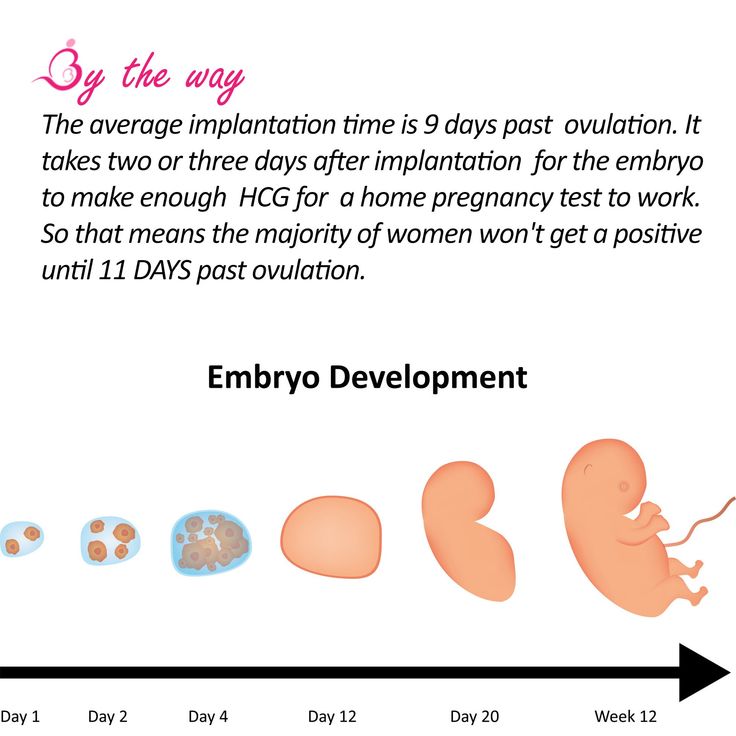Birthing standing up
Giving Birth Upright | 9 Huge Benefits
For most of human history, laboring women were free to move about as they pleased during labor. They were able to adopt upright birth positions that felt comfortable and eased the pain of contractions.
It wasn’t until the 1700s that lying down to give birth (the supine position) became the norm, thanks to obstetricians who wanted easier access for examinations. They also found it a more convenient birthing position to perform procedures such as episiotomies or forceps deliveries.
Birth moved from home into hospital during the 1900s. The medical model of maternity care became entrenched in society, along with the expectation that women would labor in the supine position – lying flat on their backs and sometimes with their legs in stirrups.
There was a complete lack of evidence to support the passive supine lying. It is a physiologically dysfunctional birth position – one of the worst birthing positions – that simply came down to doctor preference. Subsequently, it became the way doctors were trained.
However, the World Health Organization (WHO) now states that there are plenty of reasons not to lie down while in labor, and these are fully backed by evidence.
Upright positions
Upright positions include various birthing positions a woman can adopt, during labor, where her pelvis, aided by gravity, is in the best possible position to help the baby out through the birth canal. When it comes to giving birth there are many different maternal pushing positions.
Active and upright positions include birthing positions pregnant women might adopt where their hips are significantly higher than their knees. Standing up, sitting upright, and kneeling are all upright maternal positions that will facilitate birth. These are also known as flexible sacrum positions.
There is an exception to this ‘rule’: the squatting position is also considered an upright birthing position but one where the knees are usually higher than the pelvis. The squatting position is an upright position that’s especially useful at the end of the second stage of labor, if the baby is finding it difficult to negotiate the birth canal.
The squatting position is an upright position that’s especially useful at the end of the second stage of labor, if the baby is finding it difficult to negotiate the birth canal.
There are also some gravity-neutral positions, such as the side-lying position, which are good alternatives to upright positions when the woman’s mobility is impeded – for example, if a woman is disabled, or has had a heavy dose of epidural analgesia.
Giving birth upright – 9 big benefits
There are significant advantages of upright positioning for the laboring woman:
#1: Allows gravity to assist baby’s descent
Why work harder than you need to? Your uterus contracts out — or forwards — from your body. When you’re upright, you can work with gravity and your body’s natural functions in labor. When you’re lying down, you’re bearing the brunt of weight and force, which means going against gravity.
#2: Fewer interventions
When you’re giving birth upright, making use of gravity, and using your muscles more effectively, you’re less likely to need interventions, such as forceps or episiotomies. When you’re working against gravity in a dysfunctional position, both you and your baby are more likely to need help.
When you’re working against gravity in a dysfunctional position, both you and your baby are more likely to need help.
#3: More efficient contractions
When you’re upright, leaning forward, and working with gravity, your contractions and pushing efforts will become much more efficient. The contraction starts at the top of the uterus and moves downwards to dilate the cervix. There isn’t a better position to help the cervix dilate than an upright position. If you’re lying on your back, your uterus will be contracting upwards, which is not working with your body but against it.
#4: Less pain
Labor contractions guide laboring women towards the best position to adopt in the different stages of labor. Women who can move freely during labor will make frequent position changes. They’re looking for the most comfortable position at any given time.
The least painful position is the most favorable for the baby to descend through the birth canal. When you’re off your back, you’ll experience less pain than you will when giving birth lying down. This is because you have all the weight on your back and you’re working against gravity. Change position as soon as you need to, as this will help your baby’s downward movement and will give you a much less painful birth experience.
This is because you have all the weight on your back and you’re working against gravity. Change position as soon as you need to, as this will help your baby’s downward movement and will give you a much less painful birth experience.
#5: Shorter labor
When you’re working with gravity, in a position in which your body and your baby are designed to work well, your labor is likely to be much shorter. That means it is likely to be closer to ‘normal’, because lying down can slow your labor down.
Women’s childbearing experiences are backed up by research that shows that labor is considerably shorter in nulliparous women (women who are pregnant for the first time) when they adopt upright positions during labor.
#6: Better oxygen supply to your baby
When you’re lying on your back, you’re bearing the full weight of the baby, your uterus, the placenta, and all that comes with it. Doing so puts pressure on important blood supplies in your own body. Compressing the blood supply also compresses the oxygen supply to your baby.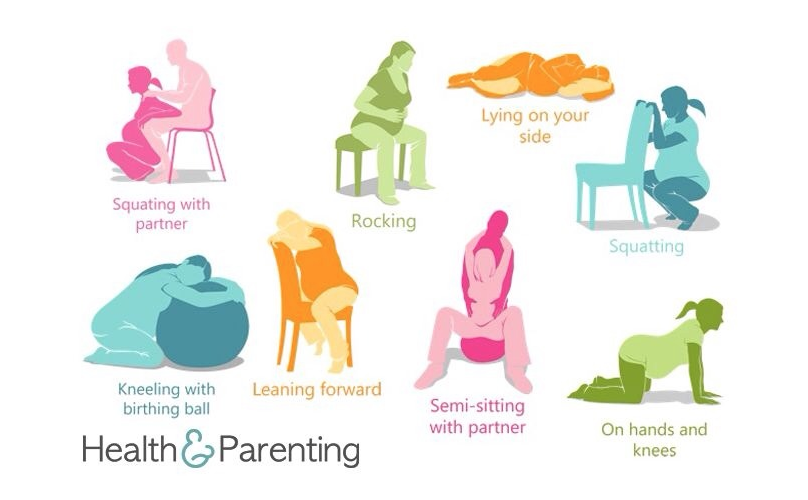 By being upright, you’ll provide a better oxygen and blood supply to your baby. Birth outcomes are better, which means that your baby will be less likely to experience fetal distress and more likely to have a normal birth. Fetal distress that cannot be rectified quickly usually results in an emergency cesarean section.
By being upright, you’ll provide a better oxygen and blood supply to your baby. Birth outcomes are better, which means that your baby will be less likely to experience fetal distress and more likely to have a normal birth. Fetal distress that cannot be rectified quickly usually results in an emergency cesarean section.
#7: Mothers’ overall satisfaction increases
If giving birth upright makes the actual birth easier, shorter, and less painful, then a mother’s overall satisfaction with the birth increases. And that’s no surprise, given what we’ve already learned: that an upright labor will really increase your chances of a normal vaginal birth, reduce recovery time and give you an oxytocin boost – all very important for a good start to motherhood.
#8: Significantly increases pelvic space
Lying down reduces pelvic diameter by about 30%. If you have concerns about having a big baby (which you shouldn’t, because your body is cleverly designed to birth), lying down will not help your body to open as well as it could. Being upright opens up your pelvis, whereas lying down closes it up. That’s why scans are inaccurate in diagnosing your pelvis’ ability to birth your baby. Adopt different positions and remain upright most of the time.
Being upright opens up your pelvis, whereas lying down closes it up. That’s why scans are inaccurate in diagnosing your pelvis’ ability to birth your baby. Adopt different positions and remain upright most of the time.
#9: Lying down forces the mother to push ‘uphill’
Pushing ‘uphill’, against gravity, can be ineffective and exhausting. Being upright means you’re pushing ‘downhill’ instead. Spontaneous pushing will happen easily if you’re upright and the efforts involved in spontaneous pushing should be much less in certain positions.
Why do hospitals make you give birth on your back?
Dr. François Mauriceau was a French obstetrician who invented the lithotomy position (where the woman lies flat on her back with her legs up in stirrups) at the end of the 17th century. Until then, birth had been women’s business but at that time, doctors started to intervene in birth and they perceived it as an illness that needed medical intervention.
This medicalized view of birth expanded quickly and women who gave birth with the help of a doctor would be placed into this lithotomy position to give birth.
Birth was then moved to hospitals and, soon after, giving birth upright was considered only for poor people in low income countries or for those in rich countries who could not afford medical care. Since then, any woman who gave birth on a hospital bed had to do it lying on her back.
Nowadays, obstetric health care providers are starting to realize how ridiculous it is to stop women from adopting any position they want when labor begins. Change usually takes a long time to happen. This is why, in some hospitals – especially where the obstetric directors are ‘old school’ – lying on the bed is almost a rule.
Can I refuse to give birth on my back?
Absolutely!
Please bear in mind that you are the one who has the last word on anything concerning your own body. Informed consent isn’t just about you saying yes to all the proposals the healthcare providers make. Informed consent is also about you being given all the information and making the final decision – even if it goes against the doctors’ recommended option.
No health care provider in any country has the right to force you into any position to give birth.
If you have doubts about the hospital where you’re planning to give birth, ask for an appointment to discuss your birthing options. Make a birth plan and take it with you to discuss it with the professionals. Ask a doula or any of your trusted family members to accompany you. If you leave that appointment feeling that your choices might not be respected, now is the time to look for a different option, not when active labor begins.
Giving birth upright – 5 position suggestions
Now you know why giving birth upright is much more beneficial to mother and baby, you might be wondering which positions are best.
Here are five birth positions that can promote effective contractions and an easier labor. Each of these positions can be used in the first and second stages of labor. Some positions might require the support of your partner, doula, or midwife. It’s important to remember that you make the decision about what is most comfortable and works best for you.
Upright Position #1: Standing
Gravity works best in this position. Baby’s head is able to apply even and direct pressure onto the cervix, helping dilation. Contractions strengthen and become regular. In this position, the laboring mother can hold on to her birth support partner, rock and sway, lean against walls, and so on. Slow walking is a variation of this position.
Upright Position #2: Hands and knees/leaning forward
Many women instinctively adopt the hands and knees position when in the later phases of the first stage and the pushing stage. This position is very adaptable and can include leaning forward over a birthing ball, a pile of cushions, or any handy piece of furniture, such as a table or bed. It allows for a full range of movement in your hips, such as rocking and swaying, which can increase comfort.
This position is also favored by women who have back labor pain, due to a posterior baby (where baby is facing frontwards or his back is against your back).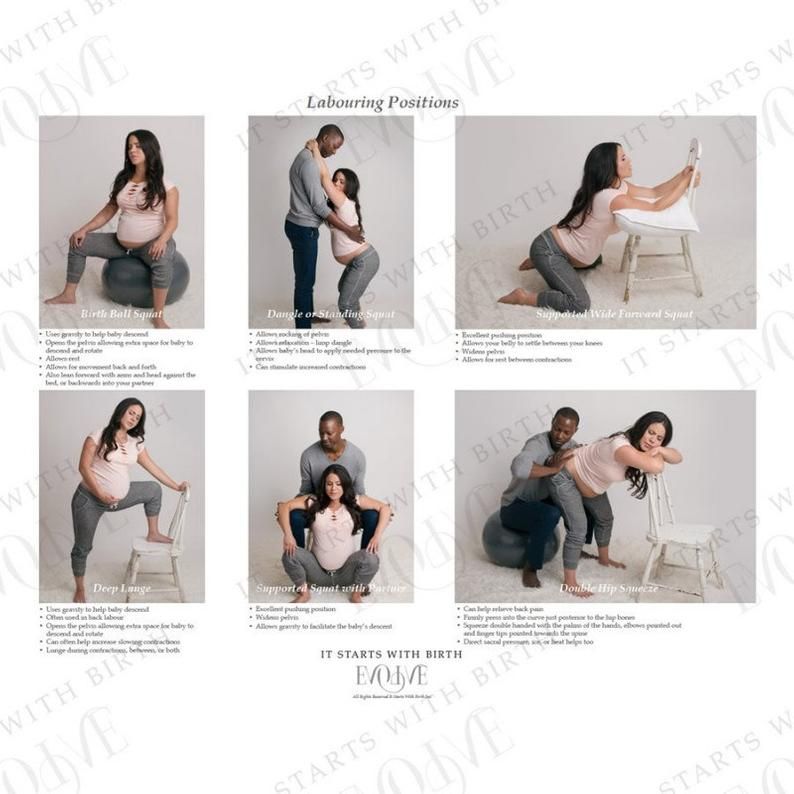 Hands and knees positioning during posterior labor can help reduce back pain and promote baby’s head turning into a more favorable position.
Hands and knees positioning during posterior labor can help reduce back pain and promote baby’s head turning into a more favorable position.
Upright Position #3: Squatting
Squatting doesn’t come naturally to women in Western cultures but it is a very powerful position to use when pushing. It’s a good idea to practice squatting during your pregnancy. Make sure you build up to it slowly, to avoid injuring yourself, and to get your muscles familiar with the position. It’s not easy to balance when you have a bump out the front, so using a wall or holding onto a doorknob can provide you with the support you need.
Squatting opens the pelvis and increases the space for baby, while allowing gravity to help baby move down without much effort.
Upright Position #4: Sitting
Some women find a lot of comfort and relief in sitting on a birth ball during labor. It allows them to rock and sway through the contractions. Sitting allows you to plant your feet wide apart and open up your hips, as well as taking pressure off your legs.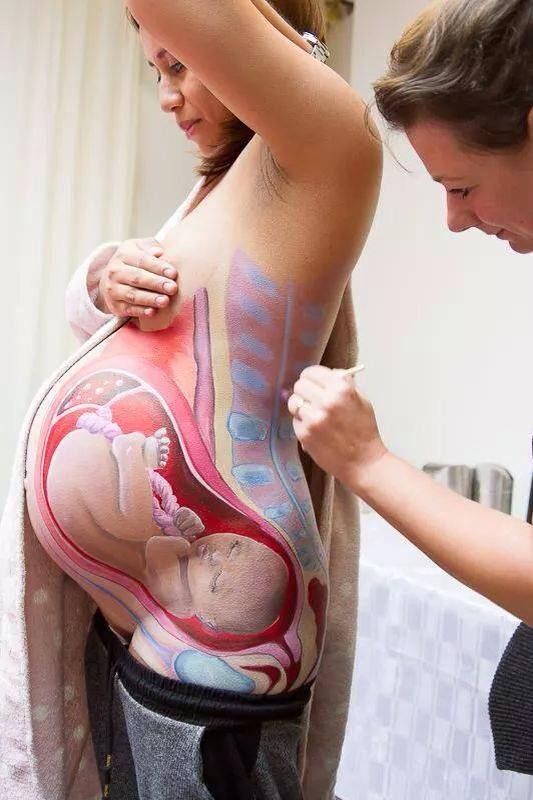
Straddling a chair and using the back as support, or even sitting on your partner’s lap and leaning forward can be very comforting. The toilet can be a great place to be during labor; it’s a place where you can feel comfortable releasing and letting go, which can help you to release and relax your pelvic floor muscles.
Upright Position #5: Lying sideways
If you have had a long labor, being able to rest without discomfort is important. Side lying allows you to relax your body without increasing pressure on major blood vessels, which can compromise blood flow to your baby. If you’ve had an epidural or need constant fetal monitoring, lying on your left side can give you the benefits of an upright position. A fast birth can also benefit from side lying (or on hands and knees), as it can help slow things down. It can also be a fantastic position from which to push baby out, particularly if you are tired and would need support to be upright.
I'm an OB/GYN who attended thousands of deliveries before wondering why Americans give birth in bed
A few years ago I visited Dar a Luz, the only free-standing birth center in New Mexico. It looks nothing like the towering urban hospitals I have spent my career working in. Nestled into a valley at the outskirts of Albuquerque, Dar a Luz is more like an earthy homestead. At the perimeter, a wood fence surrounds a sun-drenched courtyard with a rock garden and a footpath that expecting mothers pace while in labor.
It looks nothing like the towering urban hospitals I have spent my career working in. Nestled into a valley at the outskirts of Albuquerque, Dar a Luz is more like an earthy homestead. At the perimeter, a wood fence surrounds a sun-drenched courtyard with a rock garden and a footpath that expecting mothers pace while in labor.
Inside the birthing rooms are bathed in the same natural light, with open spaces designed to encourage continuous movement. Beds are in the corners of the rooms rather than the central feature. Abigail Lanin Eaves, the executive director of the birth center and a certified nurse midwife, explained that, at Dar a Luz, her patients arrive in labor walking – and usually stay that way until after the baby is born. The beds are for resting afterwards, rarely for labor or the birth itself.
Each year approximately 20,000 Americans choose to give birth out of bed, which usually requires giving birth out of hospitals. According to the CDC, centers like Dar a Luz have become 83% more popular over the last decade.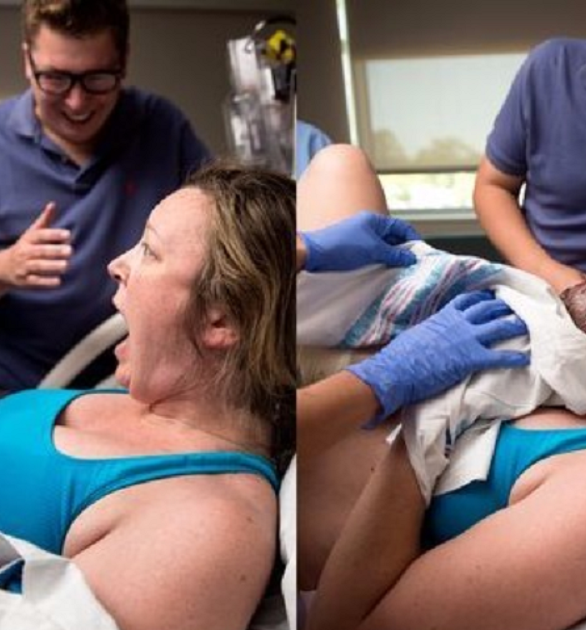 Yet millions of Americans still choose to give birth bed-bound, on their backs, with their knees up, legs spread, feet in the air. I attended the deliveries of thousands of babies before I ever wondered why.
Yet millions of Americans still choose to give birth bed-bound, on their backs, with their knees up, legs spread, feet in the air. I attended the deliveries of thousands of babies before I ever wondered why.
As an obstetrician/gynecologist, this position is familiar to me. It maximizes exposure to the pelvis during office examinations and gynecological procedures. By extension, it seems to make sense for childbirth as well, particularly from my perspective as the doctor. The work of being on call on the labor floor can be grueling, a constant race from one bed to the next. Having the people I care for remain in bed allows me to sit down, optimize my lighting, and limit the strain on my back and my eyes.
But while convenient for me, few unmedicated people would choose to labor this way. In the absence of anesthesia, it would be too uncomfortable.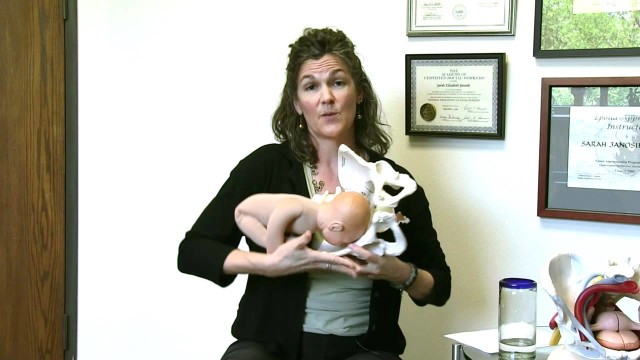 Movement is an instinctive way of coping with the discomfort of labor. Remaining upright also appears to facilitate labor progress and, aided by gravity, descent of the baby in the birth canal. By contrast, MRI studies suggest that on-the-back positioning may significantly narrow the baby’s pathway through the pelvis.
Movement is an instinctive way of coping with the discomfort of labor. Remaining upright also appears to facilitate labor progress and, aided by gravity, descent of the baby in the birth canal. By contrast, MRI studies suggest that on-the-back positioning may significantly narrow the baby’s pathway through the pelvis.
However, in the presence of anesthesia, standing and walking throughout labor is challenging if not impossible. Turning off the body’s pain receptors requires disconnecting our nerve endings from our perceptions, a process that can remove our ability to move, to remember what happened or both. Anesthesia works by blunting our most fundamental instincts. This dilemma places our desire for comfort at odds with our desire for control.
‘Blessed’ chloroform and twilight sleep
During the mid-19th century, childbirth was not an event many women were eager to actively experience. Under desperate circumstances, physicians were often called upon to surgically rescue deliveries using brute force – to place metal forceps on the baby’s head while still in the birth canal, and to strenuously pull.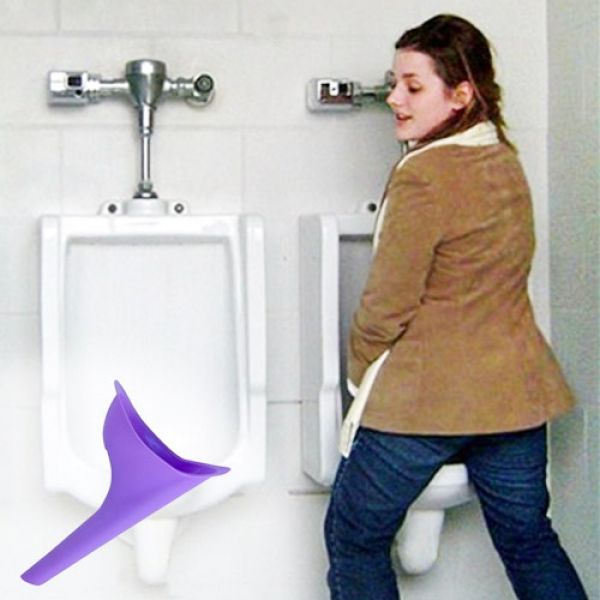 Even for the steeliest mothers, holding still would have been impossible. By contrast, inhaling chloroform, an early anesthetic, would instantly drop them into a “dreamlike” state, limp and silent, awakening hours later, peacefully and with little memory of what had happened.
Even for the steeliest mothers, holding still would have been impossible. By contrast, inhaling chloroform, an early anesthetic, would instantly drop them into a “dreamlike” state, limp and silent, awakening hours later, peacefully and with little memory of what had happened.
Chloroform was widely welcomed, even garnering an endorsement from Queen Victoria herself, who called it “blessed.” But the crude method of administering it – inhaling vapors from a rag – led to dangerously uneven dosing. If too little was given, the woman would remain awake and in pain. Yet if too much was given, they could permanently stop breathing. As anesthesia became commonplace, many overdosed and died.
A solution to this problem arrived in the early 20th century. The same effects of inhaled anesthesia could be achieved with a combination of morphine and scopolamine, intravenous medications that could be carefully measured in a syringe.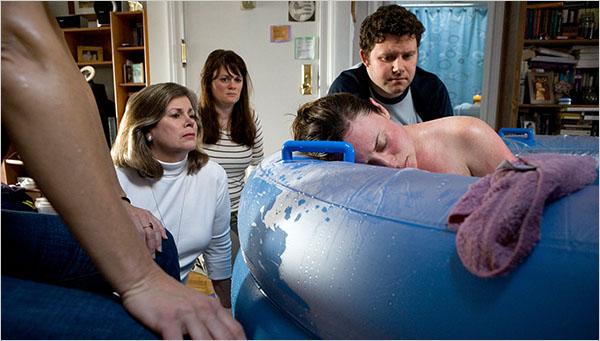 This new form of injectable anesthesia was alluringly marketed to pregnant women as “twilight sleep.” And by the 1930s it became the default approach to childbirth in the United States.
This new form of injectable anesthesia was alluringly marketed to pregnant women as “twilight sleep.” And by the 1930s it became the default approach to childbirth in the United States.
Cruelty in maternity wards
Then, in 1958 the Ladies Home Journal published a disturbing expose called “Cruelty in Maternity Wards.” In a series of letters, American nurses provided direct accounts of laboring women being left alone for hours, strapped down to beds, crying “violently” and involuntarily writhing against the restraints. At that time, fathers and other family members were not allowed in the birthing rooms to bear witness. Under heavy sedation, the memories of the mothers themselves were fuzzy.
The American public was horrified by these descriptions. Pregnant women wanted their voices back. They wanted the capacity to consent. They wanted more control.
By the 1960s, a newer technology – epidural anesthesia – offered an appealing alternative. Administered at the level of the spine, epidurals effectively bypass the brain, allowing mothers to stay awake and alert during labor, to relay their symptoms and participate in care decisions. But they also require a different trade-off. The medicine spreads out to block all nerves that relay and receive signals to and from the pelvis and thighs. These nerves mediate sensation but also control all of the key muscles in that region, from the bladder to the quadriceps.
But they also require a different trade-off. The medicine spreads out to block all nerves that relay and receive signals to and from the pelvis and thighs. These nerves mediate sensation but also control all of the key muscles in that region, from the bladder to the quadriceps.
Women with epidurals are unable to urinate on their own. A catheter must be placed to help them. Otherwise, their bladder will simply distend like a balloon. They are also unable to effectively move their legs and must remain in bed, usually for many hours. Epidurals require more intensive monitoring, a multitude of wires that act as tethers. And by removing pain as a barrier, they bring the potential for more interventions – the same epidurals used for spontaneous vaginal deliveries can be sufficiently dosed for a broad range of procedures, including cesarean sections.
Ceding control (and comfort) on their own terms
Currently, over 70% of birthing women in the U.S. receive epidurals, favoring some measure of comfort over physical control.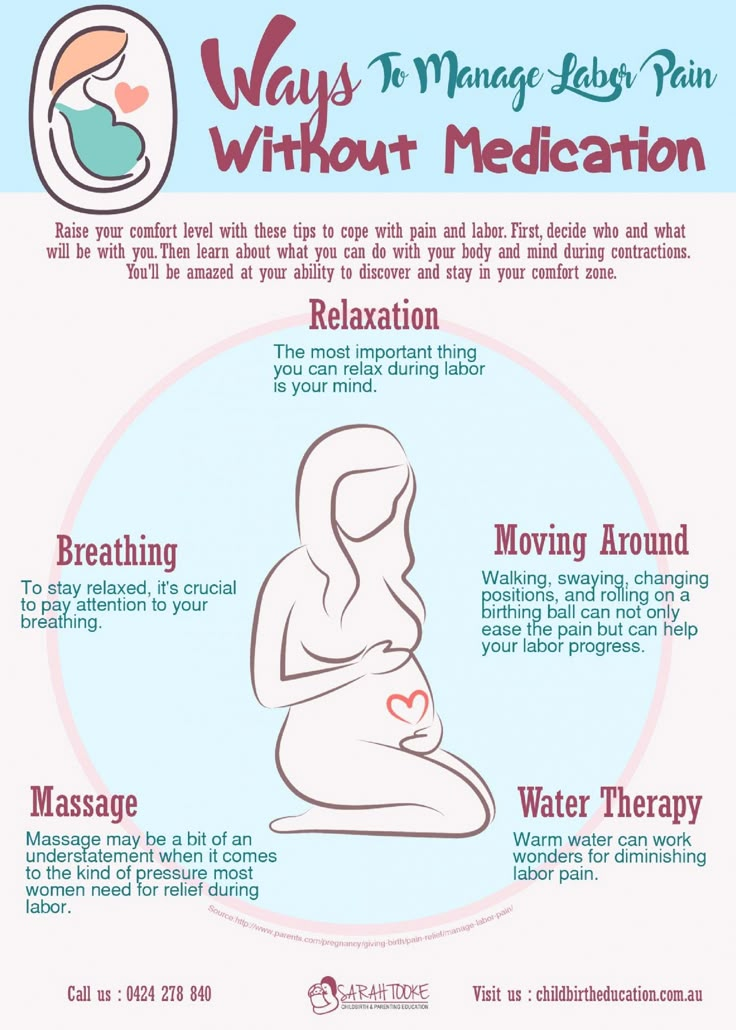 However, the popularity of Dar a Luz and other birthing centers suggests that growing numbers appear to be choosing the opposite trade-off: participation and movement over medical pain relief. Perhaps, however, the challenge is not born of anesthesia itself but rather a false choice embedded in the way it gets presented, an all-or-nothing dichotomy between “natural” and “medical.”
However, the popularity of Dar a Luz and other birthing centers suggests that growing numbers appear to be choosing the opposite trade-off: participation and movement over medical pain relief. Perhaps, however, the challenge is not born of anesthesia itself but rather a false choice embedded in the way it gets presented, an all-or-nothing dichotomy between “natural” and “medical.”
At birthing centers, epidurals are not available, and as a result, labor looks remarkably different from the hospital equivalent. While the mother may not necessarily look comfortable, her movements and her mindset more closely resemble an athlete accomplishing a feat than a patient undergoing an ordeal. Throughout, midwives are in attendance to provide support, careful monitoring and coaching.
Occasionally, complications develop during labor that make it necessary for these mothers to be transferred to the hospital. This requires acquiescing to changing circumstances and transferring some control to obstetricians and medical technology.
But the expectation of these mothers is not absolute control any more than it is absolute comfort. Most recognize that labor is neither completely controllable nor completely comfortable. They, perhaps like all people giving birth, simply seek to understand these trade-offs and have the opportunity to cede control – or comfort – on their own terms.
[ Expertise in your inbox. Sign up for The Conversation’s newsletter and get a digest of academic takes on today’s news, every day. ]
Standing birth (vertical birth) - Juno
Standing birth: content of the article
What is vertical birth and how does it work?
Childbirth in an upright position is different in that the woman at this moment does not lie down, but stands or sits. She chooses a position that is comfortable for herself. The very process of labor proceeds as usual: first, disclosure occurs, then the expulsion of the fetus, after which the afterbirth is born.
The vertical position is characteristic of most mammals, therefore it is considered physiological. Also, in some nationalities, the process of giving birth to a child occurs exclusively while standing. Now this method is becoming more and more popular. But so far it has not been implemented in all obstetric institutions. nine0008
Also, in some nationalities, the process of giving birth to a child occurs exclusively while standing. Now this method is becoming more and more popular. But so far it has not been implemented in all obstetric institutions. nine0008
Vertical delivery: advantages and disadvantages
First, let's talk about the advantages of the vertical position.
- Reduced soreness by eliminating the load on the back and the inclusion of gravity.
- It has been proven that standing birth is less painful and therefore more easily tolerated by girls. In this regard, less often resort to anesthesia.
- The risk of birth trauma is reduced, since the uterus does not press on the aorta, inferior vena cava, and spine. A woman feels muscle contractions better, knows when to relax and when to push. Thus, fetal hypoxia, which is so frequent in the classical position, does not develop. nine0017
- Less often, there is a need for medical stimulation, since contractions during childbirth while standing are already quite strong.
 In general, the use of medicines is reduced by about 10%.
In general, the use of medicines is reduced by about 10%. - The opening of the cervix, due to the uniform mechanical pressure of the fetal head and gravity, proceeds at a rapid pace, while all this happens gently, smoothly. Therefore, the first period of childbirth (contractions) is shorter.
- The third period, the successive one, also proceeds more favorably. The placenta, due to the same gravity, easily and quickly moves away from the walls of the uterus. Thus, blood loss is reduced. nine0017
- According to CTG data, the child feels better, and after birth he has higher Apgar scores, a system that assesses the condition of newborns taking into account several parameters.
Due to all these factors, a girl recovers faster after giving birth in an upright position. And the baby feels better. It is believed that such children quickly adapt to life outside the womb.
This position is especially suitable for patients with severe myopia, problems with blood vessels, heart and other conditions in which caesarean section is most often resorted to. The standing position helps to reduce the load on the girl's body and prevent complications. nine0008
The standing position helps to reduce the load on the girl's body and prevent complications. nine0008
Now let's look at what can be disadvantages in a standing position:
- In a vertical position, it is more difficult for a doctor or obstetrician to monitor the condition of the fetus, take CTG readings during attempts, listen to the baby's heartbeat;
- You should weigh the pros and cons, carefully monitor the condition of the expectant mother throughout the pregnancy, so as not to miss the anatomical features when the risk of ruptures and injuries increases. In such a situation, one should resort to operative delivery; nine0017
- Rapid labor is possible, and this is a high probability of injury to both the mother and the fetus;
- Epidural anesthesia is contraindicated, as it reduces the sensitivity of the body, the woman in labor will have difficulty in controlling sensations;
- It is more difficult for medical personnel to manipulate if problems arise during childbirth in an upright position.

Based on this, in each specific case, it is necessary to approach the issue of choosing a position for delivery individually and take into account the peculiarities of the course of pregnancy, the woman's health, the condition of the fetus and the possibilities of the obstetric institution. nine0008
Contraindications
Childbirth standing and kneeling cannot be performed if the following female and fetal factors are present:
- contractions started early;
- pregnancy occurs with complications;
- was diagnosed with a clinically narrow pelvis - in such a situation, in principle, they can give birth on their own only in exceptional cases. In this case, it is necessary to take into account the size of the fetal head, the intensity of labor, the presentation of the fetus; nine0017
- the fetus is not in the occipital presentation, but this is the most frequent and most favorable position. In other cases, the tactics of conducting childbirth should be reviewed;
- The fetal head is large or a large fetus is identified by ultrasound.
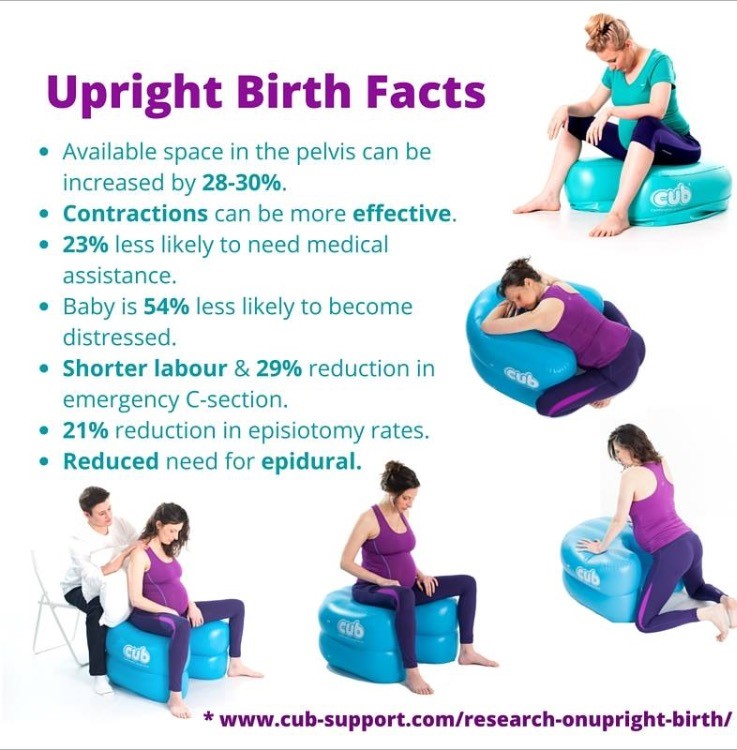 Particular attention should be paid if this diagnosis is combined with a clinically narrow pelvis;
Particular attention should be paid if this diagnosis is combined with a clinically narrow pelvis; - , the expectant mother has one or more chronic diseases that can become complicated, posing a threat to health and life. nine0017
If initially there are no contraindications, and the obstetrician-gynecologist is not against the standing position, complications are not excluded in the process of labor. In this case, the woman in labor will be placed on a chair and the further process will go in the classical position. So it is more convenient for doctors to carry out the necessary manipulations and monitor the condition of the fetus and mother.
Vertical Delivery Equipment
Firstly, you may need a fitball - a large inflatable ball, on which it is convenient to sit, reclining. It helps to evenly distribute the load on the muscles. Used only during contractions. When the 2nd period begins, you should "move over" to another device. nine0008
Secondly, a special chair. The device has a hole in the lower part, which allows the midwife to assist the woman in labor and monitor the course of the birth process. At the same time, the woman in labor herself sits, as in an ordinary chair.
The device has a hole in the lower part, which allows the midwife to assist the woman in labor and monitor the course of the birth process. At the same time, the woman in labor herself sits, as in an ordinary chair.
The third piece of equipment that can make work easier is a chair. In it, the pelvis of the woman in labor is on weight, and she can take any position. For a doctor, the device is not very convenient, as it is too low: you have to kneel. Or bend over while sitting on a chair, which is also uncomfortable if you stay in this position for a long time. But one of the advantages is that the husband can help and support, being in the same chair, which can be seen in the photo. nine0008
Entire complexes have also been developed in which several devices are combined. For example, an armchair and a high chair, you can substitute a fitball for them.
Positions for vertical birth
Vertical delivery is carried out in any position of the body that is convenient for the woman in labor. Possible options:
Possible options:
- On all fours, knee-elbow position. If you lean lower, the contractions will become less painful;
- Squatting - the woman in labor can be on the floor or on a chair. If a partner is present, she can grab the man's neck and hang on him or lean on his knees; nine0017
- Rodya standing on his feet with support. In this case, you will also need the help of a partner: he will support from behind. The woman in labor is in limbo, the muscles are relaxed: due to this, the process is accelerated;
- Squatting with the support of a partner. You need to spread your legs shoulder-width apart and, as it were, hang on your assistant, who will support you from behind. The abdomen and legs are relaxed. You can rock gently to relieve pain. This position uses the force of gravity to the maximum, and it is easier for the baby to pass through the relaxed birth canal; nine0017
- Sitting on a special chair or fitball. The ball, as we have said, can only be used in the first period;
- Childbirth on knees.
 Standing on one knee, the second leg - as if squatting. Legs can be changed so that they do not get tired.
Standing on one knee, the second leg - as if squatting. Legs can be changed so that they do not get tired.
In the 1st period, when the cervix is dilated, which is accompanied by painful contractions, the woman in labor can take any position: on all fours, kneeling on the floor, on an armchair or walking around the ward. Changing the position of the body, physical activity help reduce pain, shorten the period of contractions. For example, from giving birth on your knees, you can go to the knee-elbow position. Often the vertical method is combined with the horizontal one, since the birth process can last several hours, it is difficult for a woman in labor to be on her feet all this time. nine0008
During the period of exile, the most optimal position is squatting - so the pelvic bones diverge as much as possible, and the muscular frame relaxes, which facilitates the passage of the fetus through the birth canal. But you can sit vertically on the birthing equipment. You can rest between pushes if you get on all fours.
You can rest between pushes if you get on all fours.
3rd period - afterbirth, when the placenta moves away from the walls of the uterus and its birth occurs. At this stage, newborns are processed and given to their mother, applied to the chest. This accelerates uterine contractions after the placenta exits. Usually at this time, the puerperal lies on her back and restores her strength. nine0008
According to obstetrician-gynecologists, there is no universal position: a woman can give birth in a standing, sitting, knee-elbow and even lying position. The main thing is that she should be comfortable. In the process, she can intuitively turn around, stand up differently.
Helpful Hints
If you decide to give birth vertically, advance preparation is necessary. Consult with your doctor, check if there are any contraindications and what is the risk of perinatal complications. If the risk is low, then this alternative to the classic position can be considered. nine0008
nine0008
Do not neglect courses for pregnant women in the antenatal clinic, which you need to start attending 3-4 months before the expected date of delivery. The future dad should be next to you at this time.
In the courses, you will master vertical poses, practice with a partner, so as not to get lost at a crucial moment. Learn to relax your muscles, breathe properly, push.
There is another benefit of taking courses - they psychologically prepare expectant mothers and fathers for parenthood. You will know what awaits you, how to prepare for this period in order to live it as fully and consciously as possible, without succumbing to panic. nine0008
Also find out which hospitals offer standing and kneeling births and their hospitalization requirements. Pay attention to the list of analyzes and certificates that will need to be provided, including to the partner: without them, he will not be able to be present at the birth. If your city has private medical centers with a delivery room and special devices, a complex, you can choose them.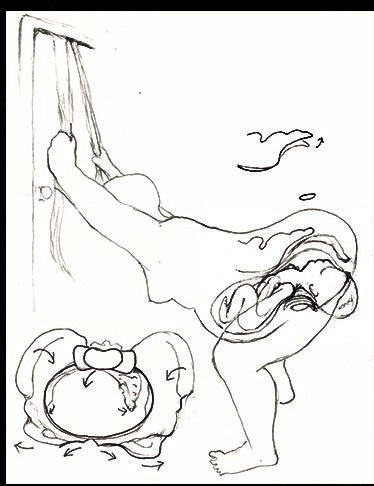 But be sure to study all the information about this institution - licenses, certificates, also read what people write about doctors, find information about their qualifications and experience. This is necessary to avoid poor quality services. nine0008
But be sure to study all the information about this institution - licenses, certificates, also read what people write about doctors, find information about their qualifications and experience. This is necessary to avoid poor quality services. nine0008
Do not forget also about the usual preparation. You will need a bag for the maternity facility, a bag for discharge, a first aid kit for the newborn, which you will use after discharge. Pharmacies have ready-made kits, but you can collect everything yourself according to your preferences.
Girls reviews
Reviews of patients who gave birth in a standing position prove that this is a comfortable position. The benefits are especially noticeable if the girl has previously given birth in the classical way while lying on her back. So, many have come to the conclusion that vertical pain is less. nine0008
The first period of labor activity is the longest, therefore it is quite energy-consuming and tiring in a vertical position. But at the same time, the advantage is the absence of ruptures in the mother and injuries in the fetus, a shortening of the duration of the period.
But at the same time, the advantage is the absence of ruptures in the mother and injuries in the fetus, a shortening of the duration of the period.
Many mothers on women's forums write that they gave birth free of charge under compulsory medical insurance. The main thing is to find out in advance during pregnancy which maternity hospitals or perinatal centers support standing birth.
The advantages of the vertical method reflect the research work that evaluates the risks, analyzes the results. Thanks to such work, we can make sure that with a competent approach, the tactics are quite working. Perhaps in the future it will become widely used in obstetric institutions. nine0008
Is it possible to give birth vertically at home
Home birth is one of the modern trends, judging by the topics on women's forums, websites, and the number of people commenting on such topics. Of course, the birth process is a natural outcome of pregnancy. But experts warn that giving birth at home is dangerous. This is especially fraught against the background of fetal and female risk factors, when the likelihood of complications, injuries and other consequences is high.
This is especially fraught against the background of fetal and female risk factors, when the likelihood of complications, injuries and other consequences is high.
Even if everything is perfect both according to the analyzes and the results of the examinations, there is no 100% guarantee that you will avoid complications. It is safer, wiser and better to give birth in a medical institution, where they can provide timely assistance to both mother and child. Such recommendations regarding horizontal and vertical methods of childbirth. nine0008
Pins
If the pregnancy proceeds without complications, the expectant mother is set to give birth on her knees, she can choose such tactics and prepare for them. Specialists in the field of obstetrics and gynecology approve the vertical method and use it as an alternative to traditional childbirth. Including this method is included in the WHO recommendation and is used to maintain activity in the process of labor.
Of course, you should evaluate the pros and cons of the standing position in each case in order to avoid complications. nine0008
nine0008
What is a vertical birth?
If you believe the ancient sources, then only the last 200-300 years, women give birth lying down. And if we turn to history, then from time immemorial they gave birth, either sitting on their knees or squatting, or in a standing position. This did not bypass Kievan Rus. The daughter of Prince Mstislav Vladimirovich and Christina of Sweden, Princess Evpraksia Mstislavovna Dobrodeya, recorded in her medical book historical and her own observations of obstetric care. Subsequently, having become the Byzantine empress under the name Zoya, she also became the first Russian author who outlined the issues of obstetrics in her writings, including “vertical” childbirth. nine0008
It was noticed that since ancient times Russian women preferred to give birth in a heated bath. It follows that the process of sweating facilitates and speeds up childbirth. The midwives who provided services during childbirth forced women in labor to actively move: walk to exhaustion, step over obstacles and anything, the main thing is not to lie down for a long time. This suggests the conclusion: such movements contribute to uterine contractions in a woman in labor.
This suggests the conclusion: such movements contribute to uterine contractions in a woman in labor.
If we trace the history of the Chinese, we can see that for many centuries they have preserved the tradition of giving birth in the sitting position of the woman giving birth. And in Holland, until recently, it was customary to give a childbirth chair as a dowry to the bride. nine0008
In our maternity hospital, we are actively implementing an alternative method of the birth process in the upright position of the woman in labor. Today, vertical births account for 60-65% of the total.
Being in an upright position, the expectant mother has the opportunity to observe the birth of her child herself. And the doctor and midwife are assigned only the role of direct observers of the natural course of childbirth.
And, most importantly, vertical childbirth does not require special equipment. So such childbirth implies complete freedom of active movements for the woman giving birth. She has the opportunity in the first stage of labor: to walk, stand, sit, rest in any position, take a warm shower and even swim. The basic principle of conducting the first stage of labor is that the woman in labor chooses a comfortable position for herself. nine0008
She has the opportunity in the first stage of labor: to walk, stand, sit, rest in any position, take a warm shower and even swim. The basic principle of conducting the first stage of labor is that the woman in labor chooses a comfortable position for herself. nine0008
In the second stage of labor, a vertical position is taken during the passage of the fetal head in a wide part of the pelvic cavity. Tradition of a vertical position is possible in various poses: standing, sitting, half-sitting, squatting, kneeling or on a specially equipped chair. The optimal vertical posture is considered to be with a slight forward lean. During this position, a woman, kneeling, slightly leaning forward (by 20-30 degrees), is located on the usual "Rakhmanov" bed.
The difference between vertical births and classical ones is that the baby is born absolutely independently. Without any help from the traditional manual perineal protection aid, which is indispensable in conventional childbirth. Another plus of the vertical posture is that the mother has the opportunity, even before the end of the pulsation of the umbilical cord and the separation of the placenta, to take the newborn in her arms and attach it to her breast.
Another plus of the vertical posture is that the mother has the opportunity, even before the end of the pulsation of the umbilical cord and the separation of the placenta, to take the newborn in her arms and attach it to her breast.
What is the biomechanism of childbirth in the vertical position of a woman with a certain inclination forward? nine0008
-
Thanks to this posture, the law of universal gravitation operates, in which the forces of natural gravity work. Consequently, it is easier for the fetus to move through the birth canal with minimal energy consumption for itself.
-
The vertical position for easy downward passage of the baby creates maximum pressure along the entire birth canal.
-
In a vertical position, the spinous processes of the vertebrae and the coccyx of the woman in labor deviate as much as possible back, while increasing the direct dimensions of the pelvic cavities. All this makes the unhindered progress of the child forward.



